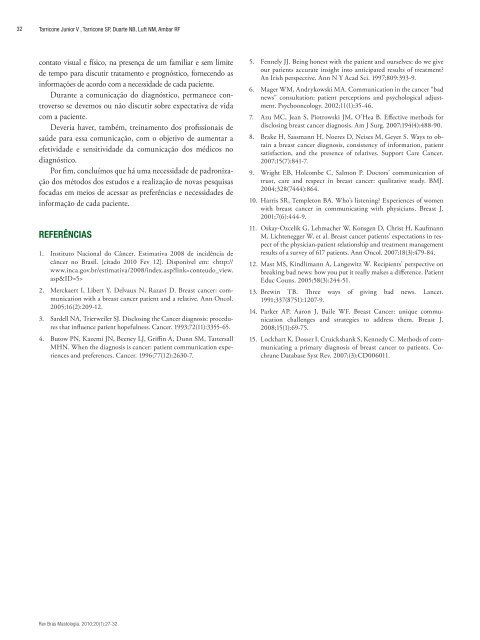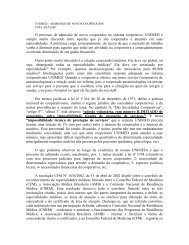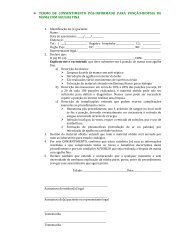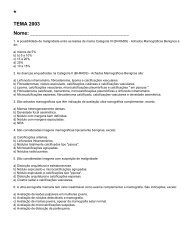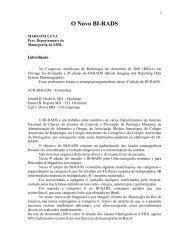Comunicação do diagnóstico de câncer de mama31move uma facilidade na comparação e é mais objetivo, porémfornece respostas limitadas, confrontado-se com o método daentrevista adotado por outros estudos, no qual há mais subjetividade,mas é de difícil comparação. Além disso, observandoa procedência dos estudos, é possível verificar um predomíniode países de origem anglo-saxônica, o que nos alerta sobre afalta de estudos latinos, que são diferentes dos analisados seconsiderarmos a cultura local, fator que pode ser o diferencialnas atitudes tomadas no momento do diagnóstico do câncer.Em 1991, Brewin descreveu três maneiras de comunicaçãopara diagnóstico de câncer. A primeira é baseada no raciocíniode que receber más notícias é uma experiência negativa e dolorosapara o paciente, e não importa a maneira de transmitir a mensagem;é identificada como “bruta e insensível”, caracterizada porfornecer informações sem o envolvimento emocional do médico,e denominada como “centrada na doença”. A segunda maneiraé identificada como “gentil e triste”, na qual o médico insiste natristeza da mensagem, demonstra um excesso de empatia e simpatia,evita criar falsas esperanças; é usado o termo “centrado naemoção” para se referir a esse tipo de estilo. A terceira e última éidentificada como “compreensiva e positiva”, sendo que o médicotransmite a informação de acordo com a necessidade do pacientenaquele momento e checa a compreensão sobre a informaçãodada, demonstra empatia e os encoraja a falar sobre seus sentimentose preocupações; chamado de “centrado no paciente”, é o modelopara comunicação de câncer mais recomendado 12 . No entanto,dentre os dois estudos que classificaram a comunicação, somenteum resultou na recomendação de um método que gerasse maiorsatisfação entre as pacientes no momento do diagnóstico, o “centradono paciente”, confirmando o achado de Brewin.Segundo a psiquiatra Elizabeth Klüber Ross, existem cincofases da morte que são: negação, raiva, barganha, depressãoe aceitação. Dependendo das características individuais, cadapaciente pode apresentar sinais mais evidentes de cada umadestas fases, não sendo necessária a presença completa de todaselas; portanto, as fases não se sucedem de forma ordenadae podem ser excludentes. Como a paciente no momento dodiagnóstico sente-se próxima da morte, por analogia estas fasespodem ser aplicadas no momento do diagnóstico.Para exemplificarmos, podemos identificar a fase de negaçãoquando a paciente comportar-se minimizando ou negando sintomase sinais, retardando o diagnóstico principalmente por ausênciade dor, “Isso não é nada, não pode estar ocorrendo comigo”.Raiva pode surgir quando a paciente comporta-se comagressividade com a equipe médica, cuidadores não-médicosou consigo mesma, geralmente atribuindo culpa a alguém ou asi própria pela ocorrência da doença, “Por que eu? Não é justo”.Barganha ocorre quando surgem promessas de recompensarmédicos e equipe, ou aspectos relacionados à religiosidadee crenças, etc. Nesta fase, é comum a ideia da possibilidade dereverter a condição com a negociação, “Caso eu me cure, voucumprir a promessa”.Depressão pode ser detectada quando as pacientes perdema autonomia de decisão “Estou muito triste, porque me preocuparcom outra coisa”.A fase de aceitação é o melhor momento de propor a formainicial de tratamento. ”Tudo vai dar certo”.Como o tratamento deve ser realizado de modo eletivo esem emergência, é importante o posicionamento médico paraorientar o momento adequado da intervenção terapêutica, deixandoa paciente elaborar sobre sua nova situação; este tempodado a paciente é muito importante. Deverá existir uma formade negociação entre paciente e equipe médica para identificar omomento ideal para iniciar um tratamento, enfatizando sempreque o tratamento do câncer de mama é longo, podendodurar anos, e desmistificando o conceito de emergência ou urgênciainterpretado pela paciente.O posicionamento médico na comunicação do câncer demama deve ser realizado em várias etapas, se necessário porvárias consultas; as informações devem ser bem compreendidase refletidas pelas pacientes e, para isto, as múltiplas visitas nafase de diagnóstico e pré-operatório determinam geralmente otempo e momento adequados.A forma da comunicação deverá ser realizada em ambientetranquilo, com o tempo necessário que a paciente precisa paraesclarecer suas dúvidas; geralmente, as pacientes vêem acompanhadase o médico deve estar capacitado para lidar com aansiedade da paciente e dos acompanhantes que se apresentamde forma diferente.Em <strong>20</strong>08, através de uma revisão, Parker et al. 13 concluíramque é fundamental promover a escolha do tratamento pelapaciente e que, no entanto, muitas pesquisas ainda precisam serrealizadas nessa área, principalmente com o intuito de encontraruma forma prática de acessar a necessidade de informaçãode cada indivíduo. Esses dados são confirmados pela nossarevisão, pois apesar dos vários indícios que apontam para a melhorforma de comunicar o diagnóstico à paciente, o meio peloqual o médico descobrirá quanta informação cada paciente necessitaainda não está bem elucidado.Em <strong>20</strong>09, Lockhart et al. 14 , por meio de uma revisão Cochrane,concluiu que a questão da comunicação do diagnósticopermanece sem resposta devido à inexistência de estudos randomizados.Os autores consideraram a hipótese de ser antiéticorandomizar as pacientes em um momento tão vulnerável, queé a espera do diagnóstico.CONCLUSÃOConcluímos que não há um padrão único e fixo para a comunicaçãodo diagnóstico do câncer de mama, tendo em vista a imensacomplexidade e variabilidade dos perfis das pacientes. Contudo,há fortes indícios de que a comunicação deve ser feita de formacentrada na paciente, com positividade e esperança, mantendoRev Bras Mastologia. <strong>20</strong>10;<strong>20</strong>(1):27-32
32Tarricone Junior V , Tarricone SP, Duarte NB, Luft NM, Ambar RFcontato visual e físico, na presença de um familiar e sem limitede tempo para discutir tratamento e prognóstico, fornecendo asinformações de acordo com a necessidade de cada paciente.Durante a comunicação do diagnóstico, permanece controversose devemos ou não discutir sobre expectativa de vidacom a paciente.Deveria haver, também, treinamento dos profissionais desaúde para essa comunicação, com o objetivo de aumentar aefetividade e sensitividade da comunicação dos médicos nodiagnóstico.Por fim, concluímos que há uma necessidade de padronizaçãodos métodos dos estudos e a realização de novas pesquisasfocadas em meios de acessar as preferências e necessidades deinformação de cada paciente.REFERÊNCIAS1. Instituto Nacional do Câncer. Estimativa <strong>20</strong>08 de incidência decâncer no Brasil. [citado <strong>20</strong>10 Fev 12]. Disponível em: 2. Merckaert I, Libert Y, Delvaux N, Razavi D. Breast cancer: communicationwith a breast cancer patient and a relative. Ann Oncol.<strong>20</strong>05;16(2):<strong>20</strong>9-12.3. Sardell NA, Trierweiler SJ. Disclosing the Cancer diagnosis: proceduresthat influence patient hopefulness. Cancer. 1993;72(11):3355-65.4. Butow PN, Kazemi JN, Beeney LJ, Griffin A, Dunn SM, TattersallMHN. When the diagnosis is cancer: patient communication experiencesand preferences. Cancer. 1996;77(12):2630-7.5. Fennely JJ. Being honest with the patient and ourselves: do we giveour patients accurate insight into anticipated results of treatment?An Irish perspective. Ann N Y Acad Sci. 1997;809:393-9.6. Mager WM, Andrykowski MA. Communication in the cancer “badnews” consultation: patient perceptions and psychological adjustment.Psychooncology. <strong>20</strong>02;11(1):35-46.7. Azu MC, Jean S, Piotrowski JM, O’Hea B. Effective methods fordisclosing breast cancer diagnosis. Am J Surg. <strong>20</strong>07;194(4):488-90.8. Brake H, Sassmann H, Noeres D, Neises M, Geyer S. Ways to obtaina breast cancer diagnosis, consistency of information, patientsatisfaction, and the presence of relatives. Support Care Cancer.<strong>20</strong>07;15(7):841-7.9. Wright EB, Holcombe C, Salmon P. Doctors’ communication oftrust, care and respect in breast cancer: qualitative study. BMJ.<strong>20</strong>04;328(7444):864.10. Harris SR, Templeton BA. Who’s listening? Experiences of womenwith breast cancer in communicating with physicians. Breast J.<strong>20</strong>01;7(6):444-9.11. Oskay-Ozcelik G, Lehmacher W, Konsgen D, Christ H, KaufmannM, Lichtenegger W, et al. Breast cancer patients’ expectations in respectof the physician-patient relationship and treatment managementresults of a survey of 617 patients. Ann Oncol. <strong>20</strong>07;18(3):479-84.12. Mast MS, Kindlimann A, Langewitz W. Recipients’ perspective onbreaking bad news: how you put it really makes a difference. PatientEduc Couns. <strong>20</strong>05;58(3):244-51.13. Brewin TB. Three ways of giving bad news. Lancet.1991;337(8751):1<strong>20</strong>7-9.14. Parker AP, Aaron J, Baile WF. Breast Cancer: unique communicationchallenges and strategies to address them. Breast J.<strong>20</strong>08;15(1):69-75.15. Lockhart K, Dosser I, Cruickshank S, Kennedy C. Methods of communicatinga primary diagnosis of breast cancer to patients. CochraneDatabase Syst Rev. <strong>20</strong>07;(3):CD006011.Rev Bras Mastologia. <strong>20</strong>10;<strong>20</strong>(1):27-32
- Page 1 and 2: ISSN 0104-8058Órgão Oficial da So
- Page 3 and 4: Ex-presidentesAlberto L. M. Coutinh
- Page 5 and 6: Sua paciente merece todocarinho na
- Page 7 and 8: cípios, em especial das grandes e
- Page 9 and 10: 4 Steinmacher DI, Kemp C, Nazário
- Page 11 and 12: 6 Steinmacher DI, Kemp C, Nazário
- Page 13 and 14: 8 Steinmacher DI, Kemp C, Nazário
- Page 15: ARTIGO ORIGINALEstudo do biomarcado
- Page 19 and 20: 14Melitto AS, Mattar A, Cintra KA,
- Page 21 and 22: 16Jardim DLF, Calabrich AFC, Katz A
- Page 23 and 24: 18Jardim DLF, Calabrich AFC, Katz A
- Page 25 and 26: 20Jardim DLF, Calabrich AFC, Katz A
- Page 27 and 28: ARTIGO ORIGINALQuality of life and
- Page 29 and 30: 24Abla LEF, Sabino Neto M , Garcia
- Page 31 and 32: 26Abla LEF, Sabino Neto M , Garcia
- Page 33 and 34: 28Tarricone Junior V , Tarricone SP
- Page 35: 30Tarricone Junior V , Tarricone SP
- Page 39 and 40: 34Manoel WJ, Paula CI, Paula ÉC, P
- Page 41 and 42: 36Manoel WJ, Paula CI, Paula ÉC, P
- Page 43 and 44: Carcinoma ductal em mama supranumé
- Page 45 and 46: 40Oliveira HR, Zucoloto FJ, Madurei
- Page 47 and 48: ARTIGO DE REVISÃOAvaliação da qu
- Page 49 and 50: 44Torres AF, Figueira Filho ASSlinf
- Page 51 and 52: 46Torres AF, Figueira Filho ASSa do
- Page 53 and 54: ARTIGO DE ATUALIZAÇÃOGenética e
- Page 55 and 56: 50Barros ACSD, Barros ACSDpara a ge
- Page 57 and 58: 52Barros ACSD, Barros ACSDverme (Ca
- Page 59 and 60: 54Barros ACSD, Barros ACSDser class
- Page 61 and 62: por todos os doentes. E o que se en
- Page 63: INSTRUÇÕES AOS AUTORESas implica


